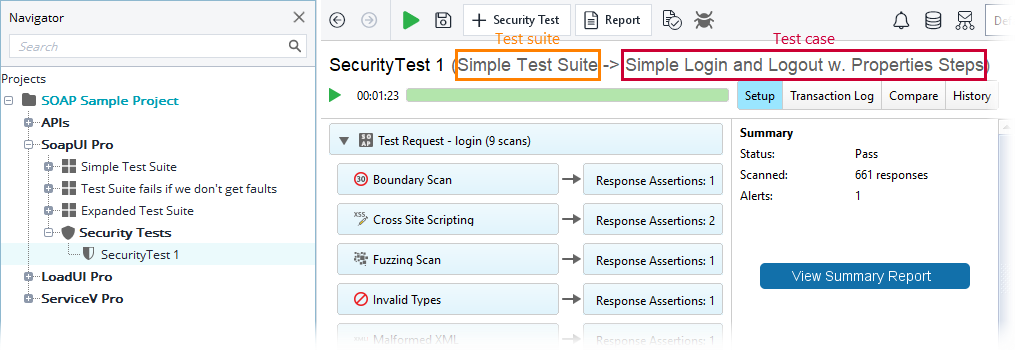Command Line Runner GUI
If you need to build a command line and check its settings, start the command line runner from the ReadyAPI user interface. See Getting Generated Command Line.
Note
To use the command line runner, you need an active ReadyAPI Test license. If you do not have a license, sign up for a free trial.
Run the utility
To launch the runner from ReadyAPI, select the appropriate menu command:
In ReadyAPI, select a security test and choose Project > Launch Security TestRunner from the main menu:

In ReadyAPI, right-click the Security Tests node in the Navigator panel and select Launch Security TestRunner:

In ReadyAPI, right-click the desired security test and select Launch Security TestRunner:

After you have selected a menu command, ReadyAPI displays a dialog box. Use it to configure the parameters of the run (see below) or copy the generated command string and run the utility from the command line.
Licensing
The security test runner is installed along with ReadyAPI and uses the same modules. It does not require any special license as it uses the existing ReadyAPI Test license you have.
Parameters
The configuration dialog organizes the utility parameters in the following tabs:
Basic tab
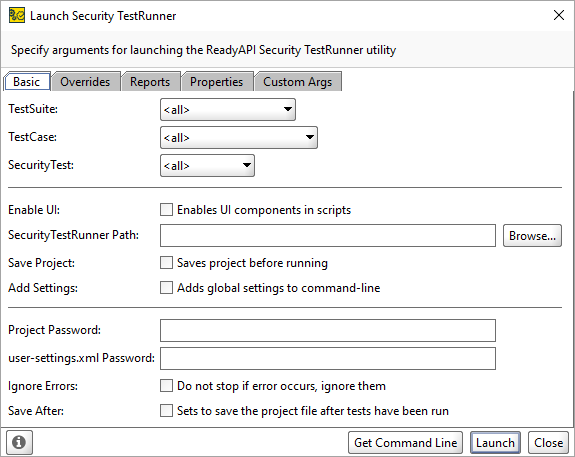 |
Parameter | Description | |
|---|---|---|
Test Suite and Test Case | Specifies for which test suite and test case a security test should run. The ReadyAPI security testing engine is based on the SoapUI engine, where security tests were part of test cases. The ReadyAPI security testing subsystem supports the SoapUI approach for specifying the security tests to be run. The test suite and test case names are available in the security test editor right after the name of your security test:
An alternative approach to specifying the security test is to use the Security Test box. The test suite and test case parameters are analogues of the | |
Security Test | Specifies a security test to be run. If this parameter is not specified, the runner executes all the security tests in the specified test case. This parameter is an analogue of the Specify a security test to be run by using this parameter, or by using a combination of the test suite and test case parameters. | |
Enable UI | Use this option to enable UI-related components. This is required if your test uses the This parameter is an analogue of the | |
Security TestRunner Path | Specifies the fully qualified name of the runner file ( | |
Save Project | This is useful to make sure that all the recent changes to the project are saved before the run. | |
Add Settings | Commands the runner to use workspace settings from the | |
Project Password | Specifies the project password, if your project is encrypted. This parameter is an analogue of the | |
user-settings.xml Password | Specifies the password for the XML setting file. This parameter is an analogue of the | |
Ignore Errors | Commands the runner to ignore errors that occur during the test run. If you select this check box, the runner will not stop the test if an error occurs. However, in this case, the runner will not log information on errors. If you keep this check box clear, the runner will stop when an error occurs and will log information about that error. This parameter is an analogue of the | |
Save After | Commands the runner to save the project after the test run finishes. This may be useful if your test stores data to the project. This parameter is an analogue of the |
Overrides tab
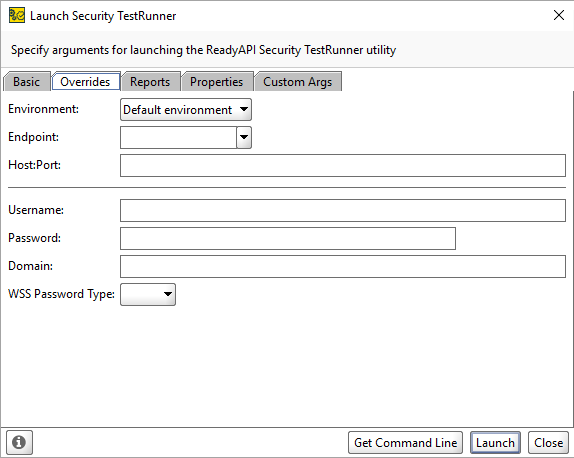 |
Parameter | Description |
|---|---|
Environment | Specifies the environment configuration for the test run. This value overrides the environment configuration selected for your project in the ReadyAPI toolbar. This parameter is an analogue of the |
Endpoint | Specifies the endpoint to be used for requests during the test run. This value overrides endpoints specified in request properties in your project. This parameter is an analogue of the |
Host:Port | Specifies the host and port to be used in requests during the test run. Usage format: This parameter is an analogue of the |
Username | Specifies a username for authorization tasks during the test run. This value overrides the usernames specified in authorization properties of test requests. This parameter is an analogue of the |
Password | Specifies a password for authorization tasks during the test run. This value overrides the password specified in authorization properties of test requests. This parameter is an analogue of the |
Domain | Specifies a domain for authorization tasks during the test run. This value overrides the domains specified in authorization properties of test requests. This parameter is an analogue of the |
WSS Password Type | Specifies the WS-Security password type. Select or to set either the This parameter is an analogue of the |
Reports tab
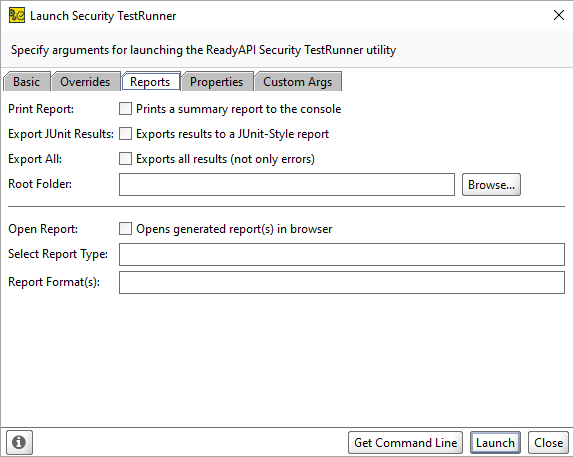 |
Parameter | Description |
|---|---|
Print Report | Commands the runner to include summary data into the generated reports. This parameter is an analogue of the Default value: enabled. |
Export JUnit Results | Commands the runner to create a JUnit-style report. This parameter is an analogue of the Default value: enabled. |
Export All | If this check box is clear, the report will contain information only about errors. If the check box is selected, the report will include messages of other types too. This parameter is an analogue of the Default value: enabled. |
Root Folder | The fully qualified name of the directory that will store exported test reports. If the specified directory does not exist, it will be created. NoteThe default value is TipIf the directory exists, files of the reports in it will be overwritten. This parameter is an analogue of the |
Open Report | Commands the runner to open the generated reports in your default browser after the test run finishes. This parameter is an analogue of the |
Select Report Type | Specifies the type of the generated report. You have the following options:
This parameter is an analogue of the |
Report Format(s) | Specifies the format of the generated report. Possible values: , , , , , , . If you keep this edit box empty, will be used. Do not specify periods in format names. To specify multiple formats, separate them with commas, for example: This parameter is an analogue of the |
For more information about reports and customization, see Reporting.
Properties tab
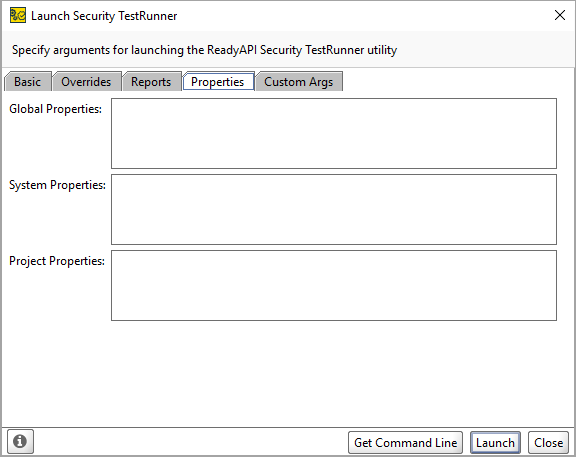 |
On the Properties tab, specify variable values that will take effect during the test run.
Use strings of the following format: <variable-name>=<value>.
Separate multiple name-value pairs with spaces or put each pair into a new line. If a variable name or value includes spaces, enclose the entire pair in quotes. For example:
file=C:\Work\File.txt image_to_upload="C:\My Application\image.png"
Property | Description |
|---|---|
Global Properties | Specifies global property values for the test run. The values you specify will override properties listed in the Global Properties settings of the ReadyAPI preferences. This parameter is an analogue of the |
System Properties | Specifies system property values for the test run. The values you specify will override these properties’ values you have in the ReadyAPI Help > System Properties dialog. This parameter is an analogue of the |
Project Properties | Specifies the project property values for the test run. The values you specify will override project-level properties. This parameter is an analogue of the |
Custom Args tab
 |
On The Custom Args tab, add any extra arguments to the runner if you need. For example, to command the runner to use a setting file that is different from default readyapi-settings.xml, enter the following text into the Tool Args edit box:
-tC:\Work\test-settings.xml
